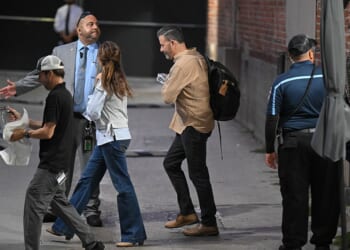In contemporary literature there have been few genres so confusingly and consistently debated as autofiction. Though generally ill-defined, and often indistinguishable from memoir, the vague genre nonetheless enjoyed a return to critical prominence in the late 2000s and 2010s — authors such as Sheila Heti, Ben Lerner and Rachel Cusk became uniquely famous for novels full of lightly fictionalised, introspective riffs on the ambiguities of their actual lives. Though, of course, no name ultimately became more synonymous with the form than Karl Ove Knausgaard, the massively successful Norwegian novelist best known for his totemic six-volume My Struggle series, in which he detailed the most mundane, day-to-day (and sometimes hour-to-hour) activities of his adolescence, marriage, and experience of fatherhood.
But since wrapping up those volumes, Knausgaard has embarked on a return to fiction with his “Morning Star” series, the fourth book of which, The School of Night, comes out in English translation this week. The same techniques from his autofictional works remain in this newest work: minute descriptions of monotonous actions, threaded with microscopic reflections in unremitting first-person monologue, peppered with long riffs on grand ideas of history, photography, family or the artistic ego. The reader is easily overwhelmed by Knausgaard’s exhaustive, solipsistic obsession with the moment-to-moment thought processes of his narrator — in this case a self-important young Norwegian artist who quickly turns out to be one of the most unlikeable, unsympathetic characters in recent fiction. “Meet Kristian Hadeland: you’ll hate him,” says one of the book’s taglines, and boy is that right.
The School of Night is an agonisingly self-aware Faust story, set mostly in a rundown Deptford, in late-Eighties Thatcherite London, with a leap forward to the present (or ostensibly close to it), later in the book. The story’s loose plot sees the young photographer Hadeland arriving from Norway to study, encountering a Dutch artist named Hans who may or may not be a demon of some kind, and negotiating a fall-out with his parents, his own growing egoism, the accidental murder of a homeless man, and the possibility that he has sold part of his soul without consciously realising it. In the last third of the book — a cancel-culture critique that does little which wasn’t done in a far more incisive way in Todd Field’s 2022 film Tár — Hadeland falls from grace, then pays for his vague Faustian pact with the death of a loved one, shattering what little world he has left. All throughout, we are privy to the misanthropic spite Hadeland shows towards nearly everything and everyone he meets. But we’re also treated to a series of speculations on mirrors, alchemy, photography and Christopher Marlowe, whose play Doctor Faustus appears frequently, and whose occult Elizabethan brotherhood gives the book its name.
These long topical disquisitions — which will be all-too-familiar to readers of the My Struggle books — are the most interesting parts of the book. They promise a proper reflection on our image-haunted, technology-obsessed world; a proper retelling of the Faust myth, for what is surely the most openly Faustian time in human history — when AI evangelists and tech billionaires quite literally warn of the Antichrist, and engineers brag about creating daemons in the data centres. And yet the book’s reflection never really leaves the level of chatter: instead it drifts like flotsam on the surface of a narrative which doesn’t seem to be capable of anything deeper than a long, slow drag through its narrator’s many attempts to achieve some greatness in his work, and avoid too much emotional entanglement with other people.
All of this happens, of course, in the same anti-style that has marred so much contemporary literary fiction, from Sally Rooney to Knausgaard himself, obsessed as it so often is with a numbly realist accounting of modern people’s narcissistic internal worlds. One would hope that a book which took for its subject the central myth of soul-killing technological and scientific progress — not to mention the occult nature of mirrors and man-made images — would depart at least somewhat from the most mundane contemporary forms of fictional narration. At the very least, it might craft for itself a proper style to reflect its key interests, or find a more expressionistic route to convey the eerie and fantastical aspects of its story. But with Kansugaard it just isn’t so. The man can apparently only tell a story in one way. At this point, I can think of no surer sign that the fixations of contemporary autofiction (and much fiction in general) are completely tapped out than the exhausting 500-or-so pages of The School of Night.
This is a shame, because Knausgaard is often an interesting thinker, with no small amount of insight into the peculiar character of our modern compulsions. In a cover story for Harper’s this June, entitled “The Reenchanted World”, Knausgaard bridged autobiography — his youthful introduction to computers, tending the garden in his London home, and a recent visit to Greece to meet the scientist James Bridle — with his trademark musings, to investigate what he describes as contemporary society’s “loss of the world”. The world, he writes, was for most of history a place that human beings might turn to, in escape — whether from God, death or self. But in the world we’ve constructed for ourselves, “everything addresses us”, all technology seems bent on abolishing the world and only further reinforcing self. And that’s not all: our technology has flooded us with an informational approximation of the same world substituted for the actual. As he writes, with no small sadness: “All the images I’ve seen of places I’ve never been, people I’ve never met create a kind of pseudomemory from a pseudoworld that I don’t participate in.”
“The man can apparently only tell a story in one way.”
Knausgaard’s general distaste for technology — and his quest to understand how science and mathematics might be used to complement our understanding of nature’s mystery, rather than reducing it — shares much with other vaguely Romantic critiques of contemporary scientism, like Iain McGilchrist’s recent books, or those of the venerable American iconoclast Wendell Berry, or Paul Kingsnorth’s recent polemic, Against the Machine: On the Unmaking of Humanity. It helps to paint a picture of our era as one in which technology has run riot and escaped from our control. In one sense this seems all too similar to the first Romantic era. Then, as now, Enlightenment confidence in new scientific discoveries and technologies began to slide into the Industrial Revolution — beginning with what the Romantic poet William Blake called England’s “Satanic Mills”.
This end-of-Enlightenment period inspired the definitive modern Faust, Johann Wolfgang von Goethe’s huge two-part poetic drama. Along with Thomas Mann’s 1947 novel Doctor Faustus, Goethe’s play is mentioned in Knausgaard’s The School of Night — a tissue of Faust stories connecting the story back to Marlowe’s play, and the alchemical legends before it. But unlike the Romantic reaction against the Newtonian mechanistic view of the universe, or even Mann’s evocation of Nazism and the technological destruction of both world wars, Knausgaard’s Faustian story is too shallow to measure up. His most interesting ideas about cameras, mirrors and art can’t survive his insistence on that exhausting monologue, which only burrows further into the contemporary preoccupations such a Faust story ought to be criticising. And besides, Knausgaard is simply too committed to the ambiguity of his scenario to make it a proper retelling of a myth. Quite simply, the novel could have used much more of the spirit of inquiry and immediacy that animated his Harper’s article. Or perhaps Knausgaard is constitutionally too personal and autofictional a writer to weave genuinely imaginative literature.
Regardless, the result is, if not quite a failure, at best half-done. The autofictional style — Knausgaard’s, yes, but really anyone’s — has simply run out of things it can do, and as The School of Night proves, is finally incapable of producing the kind of new myths we need to understand our moment. We live in an era of unprecedented acceleration and global instability. Much of our time is now spent staring at computer-generated golems cooked up by technological con-men, many of whom claim (without exaggeration) to be building a new kind of superconnected divinity. We have never been more in need of stories that speak to this insane reality — not to a continual literary addiction to the same single, narcissistic inner monologue, which one can after all already find multiplied across the internet, much of it made by machines. If Knausgaard’s novel shows us anything, it’s that the Faustian story is one of the most perennially relevant modern stories: somebody just has to figure out how to tell it again. When they do, it won’t be like this.

















